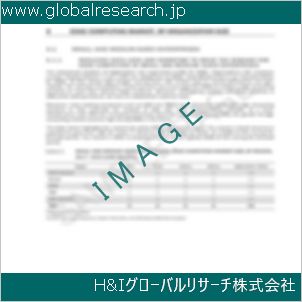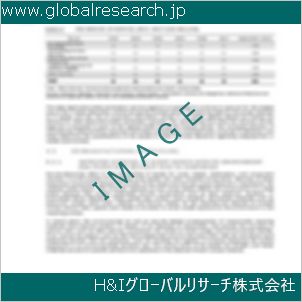1 市場概要
1.1 製品概要と範囲
1.2 市場推定の注意点と基準年
1.3 タイプ別市場分析
1.3.1 概要:グローバルな剥離可能半導体シールド化合物消費量(種類別):2020年対2024年対2031年
1.3.2 交連可能型
1.3.3 熱可塑性
1.4 用途別市場分析
1.4.1 概要:グローバル剥離可能半導体シールド化合物消費量(用途別):2020年対2024年対2031年
1.4.2 中電圧電力ケーブル
1.4.3 高電圧電力ケーブル
1.5 グローバル剥離可能半導体シールド化合物市場規模と予測
1.5.1 グローバル剥離可能半導体シールド化合物消費額(2020年、2024年、2031年)
1.5.2 グローバル剥離可能半導体シールド化合物販売数量(2020年~2031年)
1.5.3 グローバル剥離可能半導体シールド化合物平均価格(2020-2031)
2 メーカープロファイル
2.1 ボレアリス
2.1.1 ボレアリス詳細
2.1.2 ボレアリス主要事業
2.1.3 ボレアリス 剥離可能導電性シールド化合物製品およびサービス
2.1.4 ボレアリス 剥離可能導電性シールド化合物 販売数量、平均価格、売上高、粗利益率、市場シェア(2020-2025)
2.1.5 ボレアリス最近の動向/更新
2.2 ENEOS NUC
2.2.1 ENEOS NUCの詳細
2.2.2 ENEOS NUC 主な事業
2.2.3 ENEOS NUC 剥離可能導電性シールド化合物製品およびサービス
2.2.4 ENEOS NUC 剥離可能導電性シールド化合物 販売数量、平均価格、売上高、粗利益率、市場シェア(2020-2025)
2.2.5 ENEOS NUCの最近の動向/更新
2.3 Kkalpana
2.3.1 Kkalpanaの詳細
2.3.2 Kkalpana 主な事業
2.3.3 Kkalpana 剥離可能導電性シールド化合物製品およびサービス
2.3.4 Kkalpana 剥離可能半導体シールド化合物 販売数量、平均価格、売上高、粗利益率、市場シェア(2020-2025)
2.3.5 Kkalpanaの最近の動向/更新
2.4 HJポリマー中国株式会社
2.4.1 HJポリマー中国株式会社の詳細
2.4.2 HJポリマー中国株式会社の主要事業
2.4.3 HJ Polymer China Co. 剥離可能導電性シールド化合物製品およびサービス
2.4.4 HJ Polymer China Co. 剥離可能半導体シールド化合物 販売数量、平均価格、売上高、粗利益率、市場シェア(2020-2025)
2.4.5 HJ Polymer China Co. の最近の動向/更新
2.5 浙江省ワンマ
2.5.1 浙江省ワンマの詳細
2.5.2 浙江省万馬主要事業
2.5.3 浙江省万馬 剥離可能導電性シールド化合物 製品およびサービス
2.5.4 浙江省万馬剥離可能導電性シールド化合物販売数量、平均価格、売上高、粗利益率および市場シェア(2020-2025)
2.5.5 浙江省万馬の最近の動向/更新
2.6 江蘇徳威先進材料
2.6.1 江蘇徳威先進材料の詳細
2.6.2 江蘇徳威先進材料の主要事業
2.6.3 江蘇徳威先進材料 剥離可能導電性シールド化合物 製品とサービス
2.6.4 江蘇徳威先進材料 剥離可能導電性シールド化合物 販売数量、平均価格、売上高、粗利益率、市場シェア(2020-2025)
2.6.5 江蘇徳威先進材料の最近の動向/更新
2.7 蘇州双湖テクノロジー
2.7.1 蘇州双湖テクノロジーの詳細
2.7.2 蘇州双湖テクノロジー 主な事業
2.7.3 蘇州双湖テクノロジー 剥離可能導電性シールド化合物製品およびサービス
2.7.4 蘇州双湖テクノロジー 剥離可能導電性シールド化合物 販売数量、平均価格、売上高、粗利益率、市場シェア(2020-2025)
2.7.5 蘇州双湖テクノロジーの最近の動向/更新
2.8 江蘇双信新材料
2.8.1 江蘇双信新材料の詳細
2.8.2 江蘇双信新材料主要事業
2.8.3 江蘇双信新材料 剥離可能導電性シールド化合物 製品とサービス
2.8.4 江蘇双信新材料 剥離可能導電性シールド化合物 販売数量、平均価格、売上高、粗利益率、市場シェア(2020-2025)
2.8.5 江蘇双信新材料の最近の動向/更新
2.9 浙江省太湖元大新材料
2.9.1 浙江省太湖元大新材料の詳細
2.9.2 浙江省太湖元大新材料主要事業
2.9.3 浙江省太湖元大新材料 剥離可能半導体シールド化合物 製品とサービス
2.9.4 浙江省太湖元大新材料 剥離可能導電性シールド化合物 販売数量、平均価格、売上高、粗利益率、市場シェア(2020-2025)
2.9.5 浙江省太湖元大新材料の最近の動向/更新
3 競合環境:製造業者別剥離可能導電性シールド化合物
3.1 グローバル剥離可能半導体シールド化合物販売数量(メーカー別)(2020-2025)
3.2 グローバル剥離可能半導体シールド化合物売上高(メーカー別)(2020-2025)
3.3 製造メーカー別剥離可能半導体シールド化合物平均価格(2020-2025)
3.4 市場シェア分析(2024年)
3.4.1 製造メーカー別剥離可能半導体シールド化合物出荷量($MM)と市場シェア(%):2024
3.4.2 2024年の剥離可能半導体シールド化合物メーカー上位3社の市場シェア
3.4.3 2024年の剥離可能導電性シールド化合物メーカー上位6社の市場シェア
3.5 剥離可能半導体シールド化合物市場:全体的な企業足跡分析
3.5.1 剥離可能半導体シールド化合物市場:地域別足跡
3.5.2 剥離可能半導体シールド化合物市場:企業製品タイプ別市場シェア
3.5.3 剥離可能半導体シールド化合物市場:企業製品用途別足跡
3.6 新規市場参入企業と市場参入障壁
3.7 合併、買収、合意、および協力関係
4 地域別消費分析
4.1 地域別剥離可能半導体シールド化合物市場規模(グローバル)
4.1.1 地域別剥離可能半導体シールド化合物販売数量(2020-2031)
4.1.2 地域別剥離可能半導体シールド化合物消費額(2020-2031)
4.1.3 地域別剥離可能半導体シールド化合物平均価格(2020-2031)
4.2 北米の剥離可能半導体シールド化合物消費額(2020-2031)
4.3 欧州の剥離可能半導体シールド化合物消費量(2020-2031)
4.4 アジア太平洋地域 剥離可能半導体シールド化合物消費額(2020-2031)
4.5 南米 剥離可能半導体シールド化合物消費量(2020-2031)
4.6 中東・アフリカ 剥離可能半導体シールド化合物消費量(2020-2031)
5 市場セグメント別タイプ
5.1 グローバル剥離可能半導体シールド化合物販売数量(タイプ別)(2020-2031)
5.2 グローバル剥離可能半導体シールド化合物消費量(タイプ別)(2020-2031)
5.3 グローバル剥離可能半導体シールド化合物 タイプ別平均価格(2020-2031)
6 市場セグメント(用途別)
6.1 グローバル剥離可能半導体シールド化合物販売数量(用途別)(2020-2031)
6.2 剥離可能半導体シールド化合物 用途別世界消費額(2020-2031)
6.3 剥離可能半導体シールド化合物 用途別平均価格(2020-2031)
7 北米
7.1 北米 剥離可能半導体シールド化合物 種類別販売数量(2020-2031)
7.2 北米 剥離可能半導体シールド化合物 用途別販売数量(2020-2031)
7.3 北米 剥離可能半導体シールド化合物市場規模(国別)
7.3.1 北米 剥離可能半導体シールド化合物販売数量(国別)(2020-2031)
7.3.2 北米 剥離可能半導体シールド化合物 消費額(国別)(2020-2031)
7.3.3 アメリカ市場規模と予測(2020-2031)
7.3.4 カナダ市場規模と予測(2020-2031)
7.3.5 メキシコ市場規模と予測(2020-2031)
8 ヨーロッパ
8.1 欧州 剥離可能導電性シールド化合物 種類別販売数量(2020-2031)
8.2 欧州 剥離可能導電性シールド化合物 用途別販売数量(2020-2031)
8.3 欧州 剥離可能半導体シールド化合物市場規模(国別)
8.3.1 ヨーロッパ 剥離可能半導体シールド化合物販売数量(国別)(2020-2031)
8.3.2 欧州 剥離可能半導体シールド化合物 消費額(国別)(2020-2031)
8.3.3 ドイツ市場規模と予測(2020-2031)
8.3.4 フランス市場規模と予測(2020-2031)
8.3.5 イギリス市場規模と予測(2020-2031)
8.3.6 ロシア市場規模と予測(2020-2031)
8.3.7 イタリア市場規模と予測(2020-2031)
9 アジア太平洋
9.1 アジア太平洋地域 剥離可能半導体シールド化合物販売数量(種類別)(2020-2031)
9.2 アジア太平洋地域 剥離可能半導体シールド化合物 用途別販売量(2020-2031)
9.3 アジア太平洋地域 剥離可能半導体シールド化合物市場規模(地域別)
9.3.1 アジア太平洋地域 剥離可能半導体シールド化合物販売量(地域別)(2020-2031)
9.3.2 アジア太平洋地域 剥離可能半導体シールド化合物 地域別消費額(2020-2031)
9.3.3 中国市場規模と予測(2020-2031)
9.3.4 日本市場規模と予測(2020-2031)
9.3.5 韓国市場規模と予測(2020-2031)
9.3.6 インド市場規模と予測(2020-2031)
9.3.7 東南アジア市場規模と予測(2020-2031)
9.3.8 オーストラリア市場規模と予測(2020-2031)
10 南米
10.1 南米 剥離可能半導体シールド化合物販売数量(種類別)(2020-2031)
10.2 南米 剥離可能半導体シールド化合物 用途別販売数量(2020-2031)
10.3 南米 剥離可能半導体シールド化合物市場規模(国別)
10.3.1 南米 剥離可能半導体シールド化合物販売量(国別)(2020-2031)
10.3.2 南米 剥離可能半導体シールド化合物 消費額(国別)(2020-2031)
10.3.3 ブラジル市場規模と予測(2020-2031)
10.3.4 アルゼンチン市場規模と予測(2020-2031)
11 中東・アフリカ
11.1 中東・アフリカ 剥離可能半導体シールド化合物 種類別販売数量(2020-2031)
11.2 中東・アフリカ 剥離可能半導体シールド化合物 用途別販売数量(2020-2031)
11.3 中東・アフリカ 剥離可能半導体シールド化合物市場規模(国別)
11.3.1 中東・アフリカ 剥離可能半導体シールド化合物 販売数量(国別)(2020-2031)
11.3.2 中東・アフリカ 剥離可能半導体シールド化合物 消費額(国別)(2020-2031)
11.3.3 トルコ市場規模と予測(2020-2031)
11.3.4 エジプト市場規模と予測(2020-2031)
11.3.5 サウジアラビア市場規模と予測(2020-2031)
11.3.6 南アフリカ市場規模と予測(2020-2031)
12 市場動向
12.1 剥離可能半導体シールド化合物市場の成長要因
12.2 剥離可能半導体シールド化合物市場の制約要因
12.3 剥離可能半導体シールド化合物の動向分析
12.4 ポーターの5つの力分析
12.4.1 新規参入の脅威
12.4.2 供給者の交渉力
12.4.3 購入者の交渉力
12.4.4 代替品の脅威
12.4.5 競争の激化
13 原材料と産業チェーン
13.1 剥離可能導電性シールド材の原材料と主要メーカー
13.2 剥離可能半導体シールド複合材の製造コスト割合
13.3 剥離可能半導体シールド化合物の製造プロセス
13.4 産業バリューチェーン分析
14 流通チャネル別出荷量
14.1 販売チャネル
14.1.1 直接エンドユーザー向け
14.1.2 卸売業者
14.2 剥離可能半導体シールド化合物 典型的な卸売業者
14.3 剥離可能半導体シールド化合物 主要な顧客
15 研究結果と結論
16 付録
16.1 方法論
16.2 研究プロセスとデータソース
16.3 免責事項
1.1 Product Overview and Scope
1.2 Market Estimation Caveats and Base Year
1.3 Market Analysis by Type
1.3.1 Overview: Global Strippable Semi-conductive Shielding Compound Consumption Value by Type: 2020 Versus 2024 Versus 2031
1.3.2 Cross-linkable
1.3.3 Thermoplastic
1.4 Market Analysis by Application
1.4.1 Overview: Global Strippable Semi-conductive Shielding Compound Consumption Value by Application: 2020 Versus 2024 Versus 2031
1.4.2 Medium Voltage Power Cable
1.4.3 High Voltage Power Cable
1.5 Global Strippable Semi-conductive Shielding Compound Market Size & Forecast
1.5.1 Global Strippable Semi-conductive Shielding Compound Consumption Value (2020 & 2024 & 2031)
1.5.2 Global Strippable Semi-conductive Shielding Compound Sales Quantity (2020-2031)
1.5.3 Global Strippable Semi-conductive Shielding Compound Average Price (2020-2031)
2 Manufacturers Profiles
2.1 Borealis
2.1.1 Borealis Details
2.1.2 Borealis Major Business
2.1.3 Borealis Strippable Semi-conductive Shielding Compound Product and Services
2.1.4 Borealis Strippable Semi-conductive Shielding Compound Sales Quantity, Average Price, Revenue, Gross Margin and Market Share (2020-2025)
2.1.5 Borealis Recent Developments/Updates
2.2 ENEOS NUC
2.2.1 ENEOS NUC Details
2.2.2 ENEOS NUC Major Business
2.2.3 ENEOS NUC Strippable Semi-conductive Shielding Compound Product and Services
2.2.4 ENEOS NUC Strippable Semi-conductive Shielding Compound Sales Quantity, Average Price, Revenue, Gross Margin and Market Share (2020-2025)
2.2.5 ENEOS NUC Recent Developments/Updates
2.3 Kkalpana
2.3.1 Kkalpana Details
2.3.2 Kkalpana Major Business
2.3.3 Kkalpana Strippable Semi-conductive Shielding Compound Product and Services
2.3.4 Kkalpana Strippable Semi-conductive Shielding Compound Sales Quantity, Average Price, Revenue, Gross Margin and Market Share (2020-2025)
2.3.5 Kkalpana Recent Developments/Updates
2.4 HJ Polymer China Co.
2.4.1 HJ Polymer China Co. Details
2.4.2 HJ Polymer China Co. Major Business
2.4.3 HJ Polymer China Co. Strippable Semi-conductive Shielding Compound Product and Services
2.4.4 HJ Polymer China Co. Strippable Semi-conductive Shielding Compound Sales Quantity, Average Price, Revenue, Gross Margin and Market Share (2020-2025)
2.4.5 HJ Polymer China Co. Recent Developments/Updates
2.5 Zhejiang Wanma
2.5.1 Zhejiang Wanma Details
2.5.2 Zhejiang Wanma Major Business
2.5.3 Zhejiang Wanma Strippable Semi-conductive Shielding Compound Product and Services
2.5.4 Zhejiang Wanma Strippable Semi-conductive Shielding Compound Sales Quantity, Average Price, Revenue, Gross Margin and Market Share (2020-2025)
2.5.5 Zhejiang Wanma Recent Developments/Updates
2.6 Jiangsu Dewei Advanced Materials
2.6.1 Jiangsu Dewei Advanced Materials Details
2.6.2 Jiangsu Dewei Advanced Materials Major Business
2.6.3 Jiangsu Dewei Advanced Materials Strippable Semi-conductive Shielding Compound Product and Services
2.6.4 Jiangsu Dewei Advanced Materials Strippable Semi-conductive Shielding Compound Sales Quantity, Average Price, Revenue, Gross Margin and Market Share (2020-2025)
2.6.5 Jiangsu Dewei Advanced Materials Recent Developments/Updates
2.7 Suzhou Shuanghu Technology
2.7.1 Suzhou Shuanghu Technology Details
2.7.2 Suzhou Shuanghu Technology Major Business
2.7.3 Suzhou Shuanghu Technology Strippable Semi-conductive Shielding Compound Product and Services
2.7.4 Suzhou Shuanghu Technology Strippable Semi-conductive Shielding Compound Sales Quantity, Average Price, Revenue, Gross Margin and Market Share (2020-2025)
2.7.5 Suzhou Shuanghu Technology Recent Developments/Updates
2.8 Jiangsu Shuangxin New Material
2.8.1 Jiangsu Shuangxin New Material Details
2.8.2 Jiangsu Shuangxin New Material Major Business
2.8.3 Jiangsu Shuangxin New Material Strippable Semi-conductive Shielding Compound Product and Services
2.8.4 Jiangsu Shuangxin New Material Strippable Semi-conductive Shielding Compound Sales Quantity, Average Price, Revenue, Gross Margin and Market Share (2020-2025)
2.8.5 Jiangsu Shuangxin New Material Recent Developments/Updates
2.9 Zhejiang Taihu YuanDa New Material
2.9.1 Zhejiang Taihu YuanDa New Material Details
2.9.2 Zhejiang Taihu YuanDa New Material Major Business
2.9.3 Zhejiang Taihu YuanDa New Material Strippable Semi-conductive Shielding Compound Product and Services
2.9.4 Zhejiang Taihu YuanDa New Material Strippable Semi-conductive Shielding Compound Sales Quantity, Average Price, Revenue, Gross Margin and Market Share (2020-2025)
2.9.5 Zhejiang Taihu YuanDa New Material Recent Developments/Updates
3 Competitive Environment: Strippable Semi-conductive Shielding Compound by Manufacturer
3.1 Global Strippable Semi-conductive Shielding Compound Sales Quantity by Manufacturer (2020-2025)
3.2 Global Strippable Semi-conductive Shielding Compound Revenue by Manufacturer (2020-2025)
3.3 Global Strippable Semi-conductive Shielding Compound Average Price by Manufacturer (2020-2025)
3.4 Market Share Analysis (2024)
3.4.1 Producer Shipments of Strippable Semi-conductive Shielding Compound by Manufacturer Revenue ($MM) and Market Share (%): 2024
3.4.2 Top 3 Strippable Semi-conductive Shielding Compound Manufacturer Market Share in 2024
3.4.3 Top 6 Strippable Semi-conductive Shielding Compound Manufacturer Market Share in 2024
3.5 Strippable Semi-conductive Shielding Compound Market: Overall Company Footprint Analysis
3.5.1 Strippable Semi-conductive Shielding Compound Market: Region Footprint
3.5.2 Strippable Semi-conductive Shielding Compound Market: Company Product Type Footprint
3.5.3 Strippable Semi-conductive Shielding Compound Market: Company Product Application Footprint
3.6 New Market Entrants and Barriers to Market Entry
3.7 Mergers, Acquisition, Agreements, and Collaborations
4 Consumption Analysis by Region
4.1 Global Strippable Semi-conductive Shielding Compound Market Size by Region
4.1.1 Global Strippable Semi-conductive Shielding Compound Sales Quantity by Region (2020-2031)
4.1.2 Global Strippable Semi-conductive Shielding Compound Consumption Value by Region (2020-2031)
4.1.3 Global Strippable Semi-conductive Shielding Compound Average Price by Region (2020-2031)
4.2 North America Strippable Semi-conductive Shielding Compound Consumption Value (2020-2031)
4.3 Europe Strippable Semi-conductive Shielding Compound Consumption Value (2020-2031)
4.4 Asia-Pacific Strippable Semi-conductive Shielding Compound Consumption Value (2020-2031)
4.5 South America Strippable Semi-conductive Shielding Compound Consumption Value (2020-2031)
4.6 Middle East & Africa Strippable Semi-conductive Shielding Compound Consumption Value (2020-2031)
5 Market Segment by Type
5.1 Global Strippable Semi-conductive Shielding Compound Sales Quantity by Type (2020-2031)
5.2 Global Strippable Semi-conductive Shielding Compound Consumption Value by Type (2020-2031)
5.3 Global Strippable Semi-conductive Shielding Compound Average Price by Type (2020-2031)
6 Market Segment by Application
6.1 Global Strippable Semi-conductive Shielding Compound Sales Quantity by Application (2020-2031)
6.2 Global Strippable Semi-conductive Shielding Compound Consumption Value by Application (2020-2031)
6.3 Global Strippable Semi-conductive Shielding Compound Average Price by Application (2020-2031)
7 North America
7.1 North America Strippable Semi-conductive Shielding Compound Sales Quantity by Type (2020-2031)
7.2 North America Strippable Semi-conductive Shielding Compound Sales Quantity by Application (2020-2031)
7.3 North America Strippable Semi-conductive Shielding Compound Market Size by Country
7.3.1 North America Strippable Semi-conductive Shielding Compound Sales Quantity by Country (2020-2031)
7.3.2 North America Strippable Semi-conductive Shielding Compound Consumption Value by Country (2020-2031)
7.3.3 United States Market Size and Forecast (2020-2031)
7.3.4 Canada Market Size and Forecast (2020-2031)
7.3.5 Mexico Market Size and Forecast (2020-2031)
8 Europe
8.1 Europe Strippable Semi-conductive Shielding Compound Sales Quantity by Type (2020-2031)
8.2 Europe Strippable Semi-conductive Shielding Compound Sales Quantity by Application (2020-2031)
8.3 Europe Strippable Semi-conductive Shielding Compound Market Size by Country
8.3.1 Europe Strippable Semi-conductive Shielding Compound Sales Quantity by Country (2020-2031)
8.3.2 Europe Strippable Semi-conductive Shielding Compound Consumption Value by Country (2020-2031)
8.3.3 Germany Market Size and Forecast (2020-2031)
8.3.4 France Market Size and Forecast (2020-2031)
8.3.5 United Kingdom Market Size and Forecast (2020-2031)
8.3.6 Russia Market Size and Forecast (2020-2031)
8.3.7 Italy Market Size and Forecast (2020-2031)
9 Asia-Pacific
9.1 Asia-Pacific Strippable Semi-conductive Shielding Compound Sales Quantity by Type (2020-2031)
9.2 Asia-Pacific Strippable Semi-conductive Shielding Compound Sales Quantity by Application (2020-2031)
9.3 Asia-Pacific Strippable Semi-conductive Shielding Compound Market Size by Region
9.3.1 Asia-Pacific Strippable Semi-conductive Shielding Compound Sales Quantity by Region (2020-2031)
9.3.2 Asia-Pacific Strippable Semi-conductive Shielding Compound Consumption Value by Region (2020-2031)
9.3.3 China Market Size and Forecast (2020-2031)
9.3.4 Japan Market Size and Forecast (2020-2031)
9.3.5 South Korea Market Size and Forecast (2020-2031)
9.3.6 India Market Size and Forecast (2020-2031)
9.3.7 Southeast Asia Market Size and Forecast (2020-2031)
9.3.8 Australia Market Size and Forecast (2020-2031)
10 South America
10.1 South America Strippable Semi-conductive Shielding Compound Sales Quantity by Type (2020-2031)
10.2 South America Strippable Semi-conductive Shielding Compound Sales Quantity by Application (2020-2031)
10.3 South America Strippable Semi-conductive Shielding Compound Market Size by Country
10.3.1 South America Strippable Semi-conductive Shielding Compound Sales Quantity by Country (2020-2031)
10.3.2 South America Strippable Semi-conductive Shielding Compound Consumption Value by Country (2020-2031)
10.3.3 Brazil Market Size and Forecast (2020-2031)
10.3.4 Argentina Market Size and Forecast (2020-2031)
11 Middle East & Africa
11.1 Middle East & Africa Strippable Semi-conductive Shielding Compound Sales Quantity by Type (2020-2031)
11.2 Middle East & Africa Strippable Semi-conductive Shielding Compound Sales Quantity by Application (2020-2031)
11.3 Middle East & Africa Strippable Semi-conductive Shielding Compound Market Size by Country
11.3.1 Middle East & Africa Strippable Semi-conductive Shielding Compound Sales Quantity by Country (2020-2031)
11.3.2 Middle East & Africa Strippable Semi-conductive Shielding Compound Consumption Value by Country (2020-2031)
11.3.3 Turkey Market Size and Forecast (2020-2031)
11.3.4 Egypt Market Size and Forecast (2020-2031)
11.3.5 Saudi Arabia Market Size and Forecast (2020-2031)
11.3.6 South Africa Market Size and Forecast (2020-2031)
12 Market Dynamics
12.1 Strippable Semi-conductive Shielding Compound Market Drivers
12.2 Strippable Semi-conductive Shielding Compound Market Restraints
12.3 Strippable Semi-conductive Shielding Compound Trends Analysis
12.4 Porters Five Forces Analysis
12.4.1 Threat of New Entrants
12.4.2 Bargaining Power of Suppliers
12.4.3 Bargaining Power of Buyers
12.4.4 Threat of Substitutes
12.4.5 Competitive Rivalry
13 Raw Material and Industry Chain
13.1 Raw Material of Strippable Semi-conductive Shielding Compound and Key Manufacturers
13.2 Manufacturing Costs Percentage of Strippable Semi-conductive Shielding Compound
13.3 Strippable Semi-conductive Shielding Compound Production Process
13.4 Industry Value Chain Analysis
14 Shipments by Distribution Channel
14.1 Sales Channel
14.1.1 Direct to End-User
14.1.2 Distributors
14.2 Strippable Semi-conductive Shielding Compound Typical Distributors
14.3 Strippable Semi-conductive Shielding Compound Typical Customers
15 Research Findings and Conclusion
16 Appendix
16.1 Methodology
16.2 Research Process and Data Source
16.3 Disclaimer
| ※参考情報 剥離可能型半導電性シールドコンパウンドについての概念を、以下に詳述いたします。 剥離可能型半導電性シールドコンパウンドとは、主に電気ケーブルやワイヤーのシールドを形成するために使用される特殊な材料の一種です。この材料は、電気的および機械的特性を兼ね備えており、特に高電圧および高周波の電気伝導を必要とする環境での使用が考慮されています。半導電性シールドコンパウンドは、電磁干渉(EMI)や無線周波数干渉(RFI)からの保護を行うために、絶縁体の外側に配置されることが一般的です。 このコンパウンドの特長としては、まず第一に、その剥離可能性があります。一般的なシールド材料は、ケーブルの製造過程で直接接着されることが多いのに対し、剥離可能型は、必要に応じて後から容易に剥離できるため、メンテナンスや修理の際に非常に便利です。剥離可能な特性により、シールドの交換や再利用が可能となります。 次に、半導電性という点においては、このコンパウンドが微細な導電性材料を含むことから、導電性のあるシールド層を形成することができます。この導電性により、電磁波からの保護が実現しており、デバイスが外部からの干渉に対して高い耐性を持つことが可能になります。また、電流の流れによる発熱の問題を軽減する効果もあります。 剥離可能型半導電性シールドコンパウンドの種類には、主に二つのタイプがあります。一つは、熱硬化型のものと、もう一つは、熱可塑性のものです。熱硬化型のコンパウンドは、一度硬化されると再び柔らかくすることができないため、使用後の剥離が難しいという特性があります。一方、熱可塑性のコンパウンドは、加熱することで柔らかくなり、冷却されることで再び硬化します。この特性により、容易に剥離や再加工が可能です。 用途としては、主に電気通信ケーブル、高電圧送電線、産業用機器、電磁干渉を受けやすいデバイスの保護などが挙げられます。特に、通信インフラに関する要件が厳しい現代においては、剥離可能型半導電性シールドコンパウンドは、その便利さと高性能から、ますます重要な役割を果たしています。 関連技術としては、シールドコンパウンドの材料には導電性ポリマーやカーボンナノチューブなどが用いられています。これらの材料は、軽量でありながら高い導電性を持ち、シールド性能を向上させます。また、ナノテクノロジーの進展により、より高性能なシールド材料の開発が進められています。これにより、従来のシールド技術との違いが生まれ、さらなる応用が期待される状況です。 このシールドコンパウンドは、将来的には電気自動車や再生可能エネルギーインフラにも広く使われることが考えられています。従来の産業の枠を超えた新たな市場が生まれる中で、剥離可能型半導電性シールドコンパウンドは、その特性を活かし、新たな需要に応えることが期待されています。 以上のように、剥離可能型半導電性シールドコンパウンドは、その独自の特性から多様な分野で利用されており、今後の技術進展に伴ってさらなる発展が期待されます。これにより、従来の素材では対処しきれなかった問題を解決するための重要な材料として、引き続き注目されることでしょう。 |
❖ 免責事項 ❖
http://www.globalresearch.jp/disclaimer












